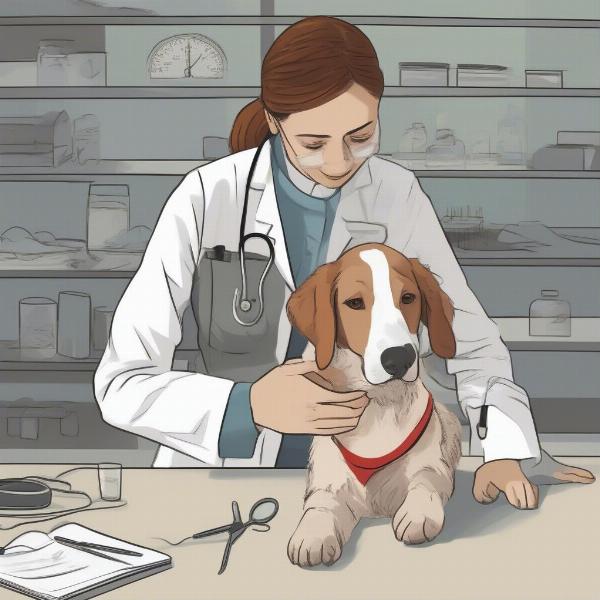Sensitive dog food is specially formulated to cater to dogs with digestive sensitivities or allergies. Choosing the right sensitive dog food can significantly improve your dog’s health and well-being. This guide will explore the nuances of sensitive dog food, helping you navigate the options and make informed decisions for your furry friend.
Understanding the Need for Sensitive Dog Food
Why do some dogs need sensitive dog food? Many dogs suffer from food sensitivities or intolerances, which can manifest in various ways, from itchy skin and ear infections to vomiting and diarrhea. These sensitivities occur when a dog’s immune system reacts negatively to specific ingredients in their food, often common proteins like beef, chicken, or dairy. Sensitive dog foods are designed to minimize these reactions by using limited ingredient diets or novel protein sources.
Choosing the Right Sensitive Dog Food: Key Considerations
Selecting the right sensitive dog food can feel overwhelming with so many options available. Here’s a breakdown of essential factors to consider:
- Limited Ingredient Diets: These formulas contain a reduced number of ingredients, making it easier to identify and avoid potential allergens. Look for foods with a single source of novel protein and a limited number of carbohydrates.
- Novel Proteins: Novel proteins are protein sources that your dog hasn’t been exposed to before, reducing the likelihood of an allergic reaction. Examples include venison, duck, kangaroo, and hydrolyzed proteins.
- Grain-Free Options: While not all dogs with sensitivities are also gluten intolerant, grain-free options can be beneficial for some. However, it’s important to consult with your veterinarian as there have been some concerns raised about the link between grain-free diets and heart conditions in dogs.
- Hydrolyzed Protein: In hydrolyzed protein diets, the protein is broken down into smaller pieces, making it less likely to trigger an immune response. These diets are often recommended for dogs with severe food allergies.
Transitioning to Sensitive Dog Food
Switching your dog to a new food should be done gradually to avoid digestive upset. Start by mixing a small amount of the new food with their current food, gradually increasing the proportion of the new food over 7-10 days. Monitor your dog for any signs of discomfort or allergic reactions during the transition period.
Common Ingredients to Avoid in Sensitive Dog Food
Certain ingredients are common culprits in triggering food sensitivities. These include:
- Beef: A prevalent protein source, beef is a common allergen for dogs.
- Chicken: Another common protein source that can cause sensitivities.
- Dairy: Lactose intolerance is common in dogs, leading to digestive issues.
- Wheat: Gluten, a protein found in wheat, can trigger sensitivities in some dogs.
- Corn: Often used as a filler, corn can be difficult for some dogs to digest.
- Soy: A common allergen for both dogs and humans.
 Veterinarian examining a dog
Veterinarian examining a dog
What if My Dog Still Shows Symptoms?
If your dog continues to experience symptoms even after switching to a sensitive dog food, consult with your veterinarian. They can perform allergy testing to identify specific allergens and recommend the best course of action.
Conclusion
Choosing supercoat sensitive dog food requires careful consideration of your dog’s individual needs. By understanding the key factors and consulting with your veterinarian, you can select the best sensitive dog food to help your furry companion thrive.
FAQ
-
What are the signs of food sensitivities in dogs? Answer: Common signs include itchy skin, ear infections, vomiting, diarrhea, excessive licking, and paw chewing.
-
How do I know if my dog needs sensitive dog food? Answer: If your dog exhibits symptoms of food sensitivities, consult your veterinarian. They can help determine the underlying cause and recommend appropriate dietary changes.
-
Are grain-free diets always better for sensitive dogs? Answer: Not necessarily. While grain-free can be helpful for some, consult your vet as there are potential concerns linked to grain-free diets.
-
How long does it take to see results after switching to sensitive dog food? Answer: It can take several weeks or even months to see noticeable improvements.
-
Can I make homemade sensitive dog food? Answer: It’s possible, but it’s crucial to consult a veterinary nutritionist to ensure a balanced and complete diet.
-
Is burns sensitive dog food expensive? Answer: Sensitive dog food can be more expensive than standard dog food, but the cost varies depending on the brand and ingredients.
-
Where can I buy sensitive dog food? Answer: Sensitive dog food is available at pet stores, veterinary clinics, and online retailers.
Related Articles:
About ILM Dog:
ILM Dog is your trusted global resource for all things dog-related. We offer expert advice on dog breeds, health, training, nutrition, grooming, and much more. Our aim is to empower dog owners with the knowledge and resources they need to provide the best possible care for their furry companions. Whether you’re a seasoned dog owner or just starting your journey, ILM Dog has the information you need. Contact us at [email protected] or +44 20-3965-8624 for personalized guidance.